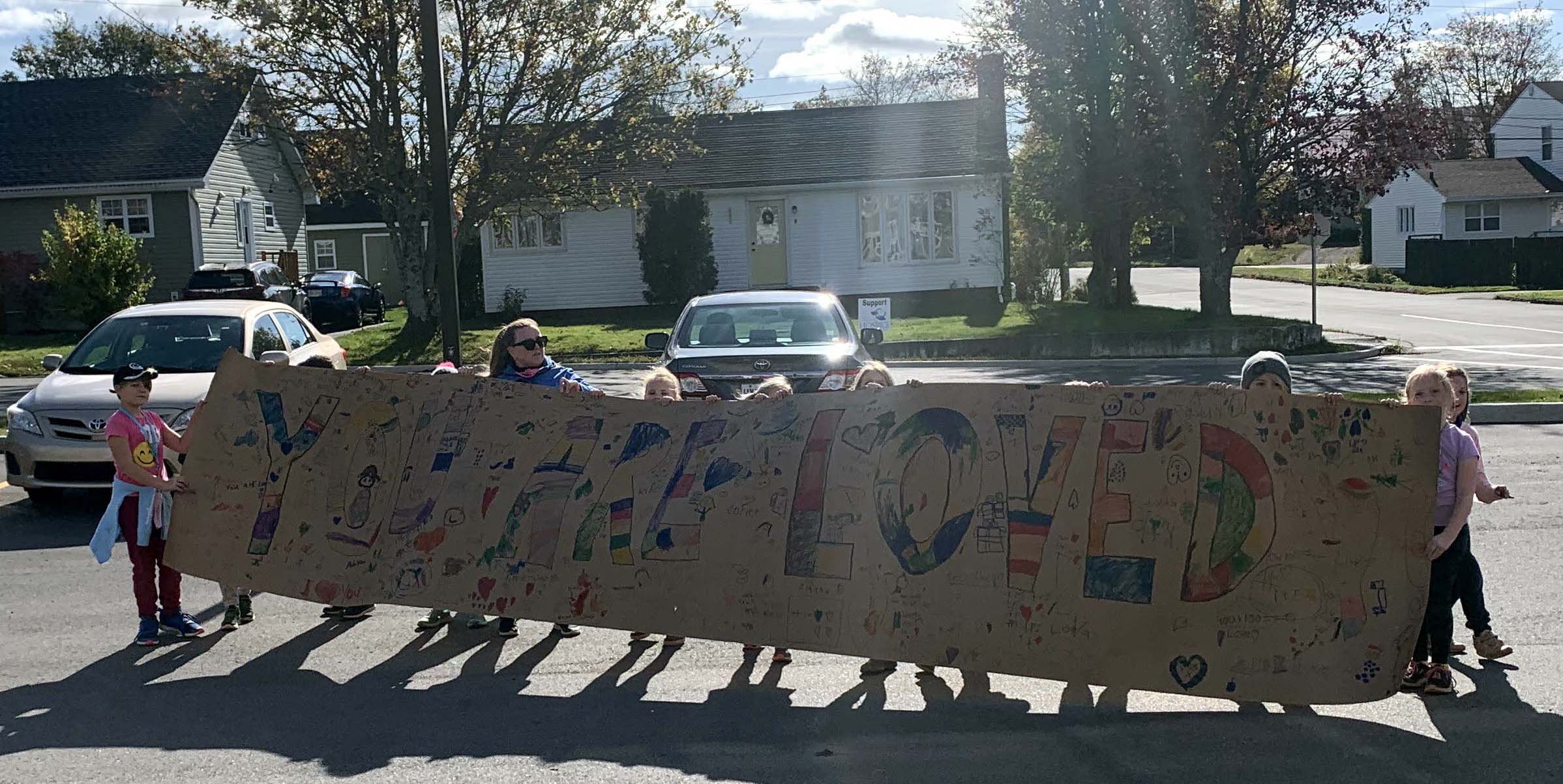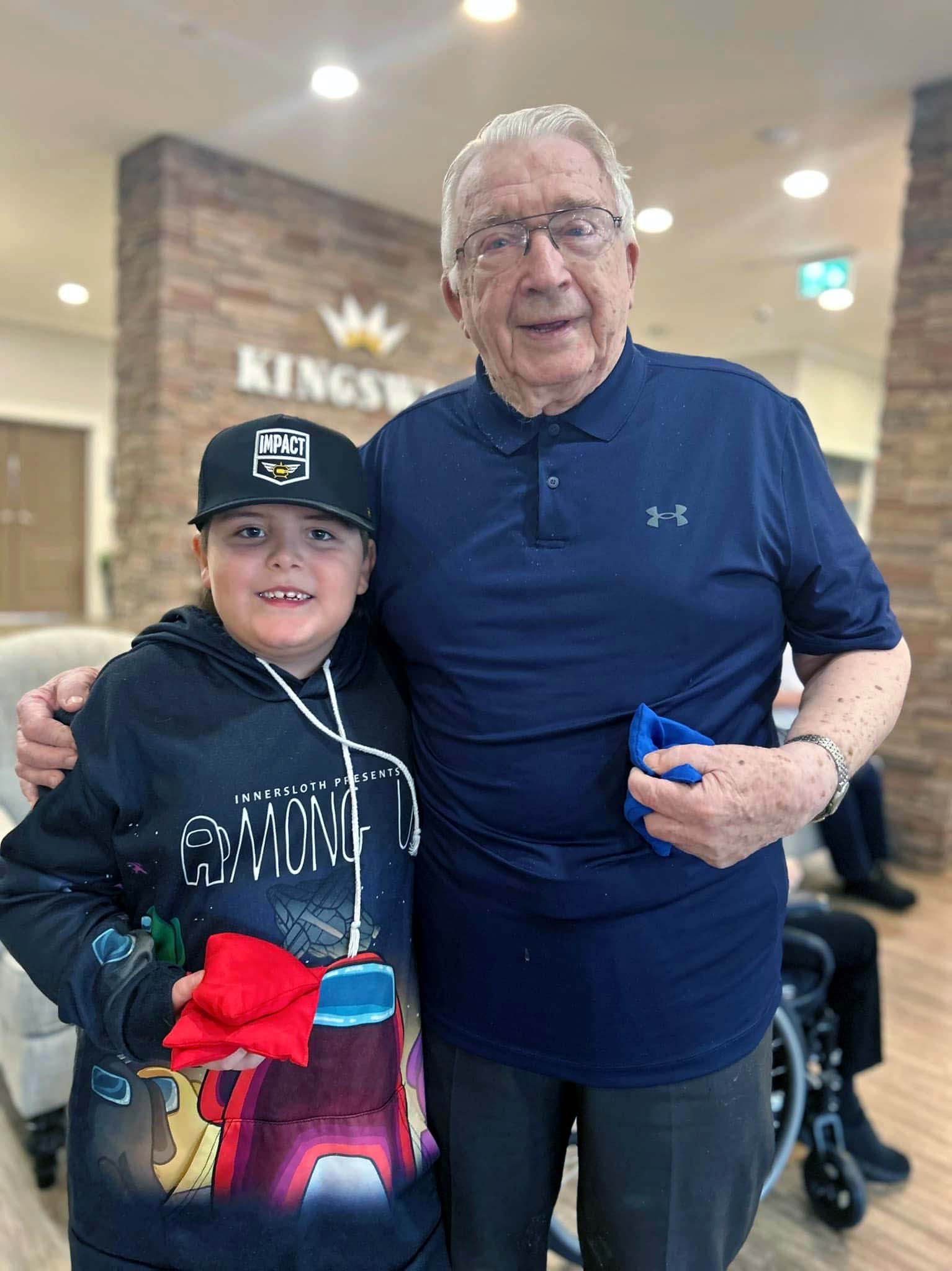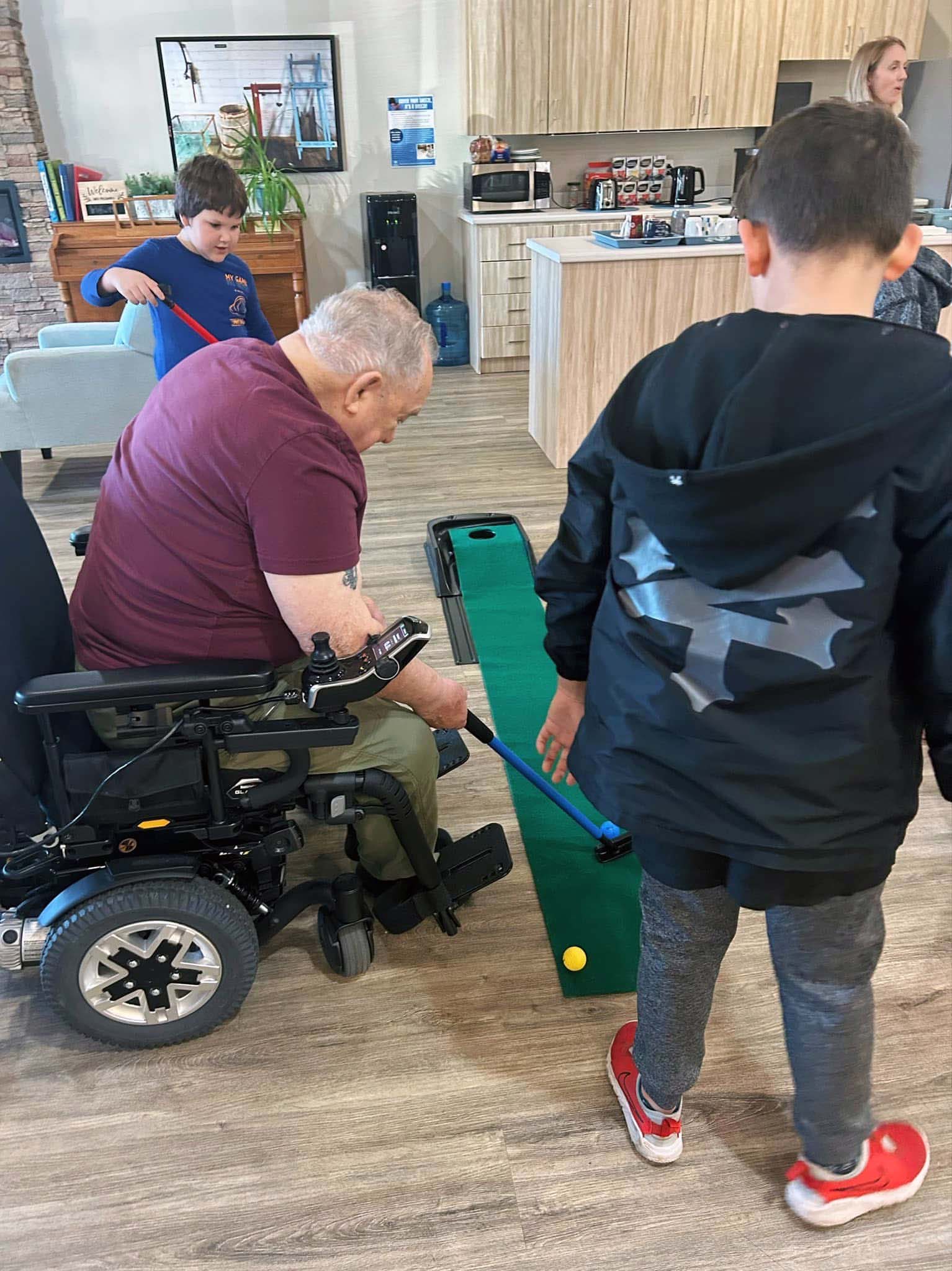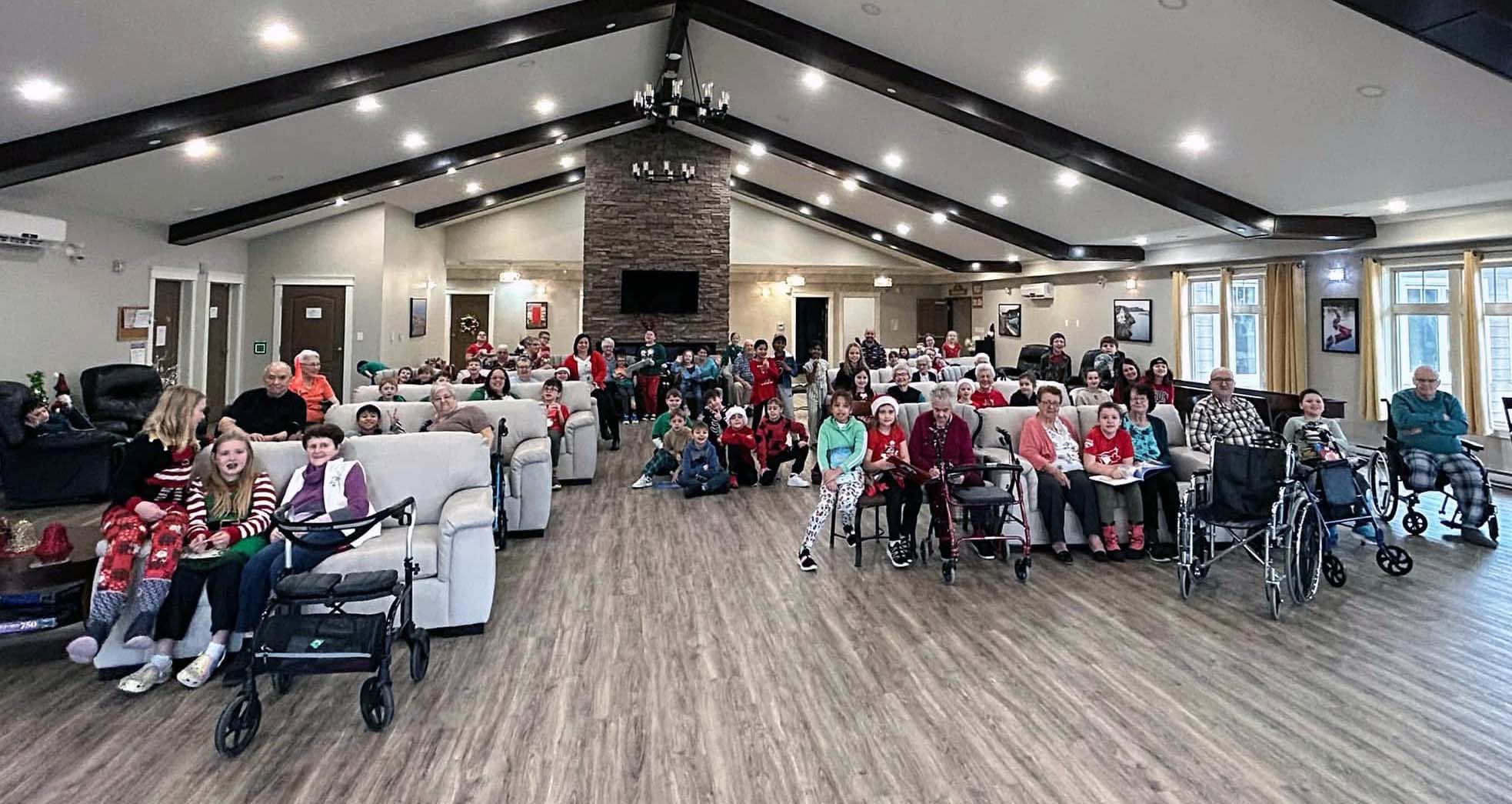It all started with a simple idea: a banner with the words, “You are loved.”
Nestled in the heart of Grand Falls-Windsor, Newfoundland and Labrador, a subtle transformation is taking place. Danielle LeDrew, a teacher fueled by boundless enthusiasm at Woodland Primary, has stitched together the young and the young-at-heart through an intergenerational program that’s as much about empathy as it is about exercise.
“Kingsway Living [retirement home] is just a flight of stairs away from our primary school—about 20 steps,” LeDrew chuckles. “It was the perfect opportunity to teach our students lessons in empathy and compassion.”
LeDrew and her Grade 3 classes started connecting with the Kingsway residents in 2019 just before the COVID-19 pandemic by making a giant ‘You are loved’ banner to hold up outside the retirement home.

From there, during lockdown when no contact was allowed, the kids continued with performing outdoor activities, like a Halloween parade and Christmas concerts. But LeDrew had bigger dreams.
That’s when she spotted an opportunity to apply for a $5,000 Team Canada Olympic Day Grant for Canadian schools with the goal of empowering students to play and stay in sport. With that grant, she knew it was time to take the program to the next level.
“The grant gave us the perfect chance to add physical activity to our visits,” she says. The grant not only brought funding but also a motivational speech from a Team Canada athlete. It was the perfect way to energize the students and seniors alike.
Fast forward a few years, and with the help of Samara, Kingsway’s recreational director, this program has blossomed into a weekly rendezvous filled with physical activities and heartfelt connections. LeDrew had no idea that one gesture would blossom into a program that now bridges generations through the power of play.
“The children and the residents have a lot to learn from each other,” Samara says. “Everyone leaves with an improved mood and greater happiness. It keeps everyone physically active and mentally engaged. It’s a perfect program for both children and seniors.”
Intergenerational programs (IGPs), which have been around for more than 40 years in several countries, can take many forms, from one-time events to ongoing activities, and often focus on sharing skills, knowledge, or experiences. These programs aim to foster understanding and appreciation, helping participants recognize the value of each other’s wisdom and perspectives. They build social networks and friendships while addressing broader social challenges, such as health concerns affecting older adults. Whether the goal is to improve academic outcomes, enhance social well-being, or support economic resilience, intergenerational initiatives create opportunities for meaningful connections that benefit all involved (Giraudeau & Bailly, 2019).
These IGPs like Woodland’s are rooted in Erikson’s lifespan approach (Erikson, 1963) and Allport’s contact theory (Allport, 1954). Erikson emphasized the mutual benefits of relationships between children and older adults, highlighting how their parallel developmental needs create a unique interaction. This concept, often observed in immediate families, can be replicated in social models to foster meaningful connections. Allport’s contact theory suggests that interactions between different groups, like generations, reduce negative attitudes and encourage positive change. These theories guide the design of intergenerational programs, offering strategies for effective activities, scheduling, and staff training, all aimed at promoting learning, reducing isolation, and building empathy across generations.
Mutual benefits
The program has had a profound impact on both the students and the seniors. As the IGP evolved into weekly visits, the variety of activities also evolved from arts and crafts to skipping ropes, mini-golf and yoga.


“We even have residents trying their hand at skipping,” LeDrew says. “We set up mini-golf, and sometimes they do yoga or free weights if they’re up to it. The kids help residents who aren’t as mobile by fetching balls or helping them hold a golf club.”
Verna, an 81-year-old grandmother and great-grandmother, lights up when talking about eagerly awaiting these visits.
“Well, actually, I couldn’t wait [for the kids to come] because being in a retirement home and missing my grandkids and great-grandchild, I thought this was a great chance for kids to come. And I was really excited about it,” Verna shares. “As soon as the little boys come in and spy me, they say, okay, come on, we gotta play mini golf or beanbag toss. They won’t let me sit down and colour. I got to be active, but I love it.”
For Beryl, 71, who has been at Kingsway Living for 9 months and always “on the go,” the program offered a way to connect. “I came to see what it was all about,” she says. ” Like Verna said, you’re away from home, you’re missing your kids, your grandkids… and it’s a way for us to associate. Not replace, but a way to connect.”
A lesson in connection
The impact on the students has been profound because the sessions aren’t just about physical activity; they’re also about forming bonds.
“The kids naturally form connections,” LeDrew says. “Our children that struggle the most in other areas, like academics and behaviours, all of that gets worked out the minute that they walk in the door.”
LeDrew mentions one child that has at times struggled to connect with his peers or create lasting social circles.
“He came up to me two weeks ago and said he had a great day and when he came back, I said to him, ‘so what did you think?’. And he said, ‘Mrs. LeDrew, I would go there any day before I’d go to my best friend’s house’… because for him, this is actually a conviction. They make him feel wanted, and loved, and cared for, and needed. So, he feels nurtured here, right?”
The program also shatters preconceived notions about aging. It’s easy for children to imagine that the residents at Kingsway have always been as they are now, living quietly in the home, their pasts a mystery. But one moment, LeDrew says, changed that perception entirely. A young boy who played hockey met a resident who casually revealed, “I’m in the Hockey Hall of Fame.” The boy, incredulous, insisted it couldn’t be true, to which the gentleman responded, “I’ve got the proof in my room. Come see!” That encounter opened the boy’s eyes to the rich, accomplished lives the residents had led before coming to Kingsway. Another resident shared stories about serving in the armed forces, recounting moments of bravery and purpose. These exchanges not only spark wonder in the children, LeDrew explains, but also deepens their empathy and respect.
The students now eagerly anticipate their visits.
“Every morning, they ask, ‘How many more days until we get to Kingsway?'” LeDrew shares. “It’s become such a meaningful part of their lives. It’s about making connections, and those connections are priceless.”
A teacher’s perspective
Teaching for 15 years and at Woodland Primary School for 7, LeDrew emphasizes the broader educational goals of the program.

“The government dictates what we teach, but they also want us to teach students to be global citizens… who are empathetic, kind, compassionate, nurturing human beings that know how to make a connection and relate to others,” she explains. “So, I always say to people, that’s what matters most. I mean, at the end of the day, can they connect with someone? Can they empathize with their emotions? Can they have good conversations? Can they feel compassion? So, for me, in all honesty, this is the best thing I’ve ever taught. There’s nothing more that will teach these children in the moments that they have here. There’s no book, there’s no curriculum guide, there’s nothing that could teach them like this program does.”
While the close proximity of the retirement home to Woodland makes the program logistically friendly, LeDrew acknowledges the potential barrier for other schools that don’t have the same setup. But she is also quick to highlight the practical benefits of the program even if they had to deal with transporting the kids to a residence.
“The cost of busing might be a concern [for other schools who don’t have a facility close by to visit], but the benefits far outweigh the expenses,” she argues. “There are far fewer instances of disrespect and the improvements in student behaviour and the emotional well-being of both students and seniors make it a worthwhile investment.”
So, in Grand Falls-Windsor, a simple flight of stairs has become a bridge connecting generations, fostering empathy, compassion, and a shared joy of life. Through physical activity and heartfelt interaction, this has grown into a powerful program that enriches lives on both ends of the age spectrum. Thanks to LeDrew’s vision and the support of the Team Canada Olympic Day Grant, Woodland Primary and Kingsway Living have become more than just neighbours.